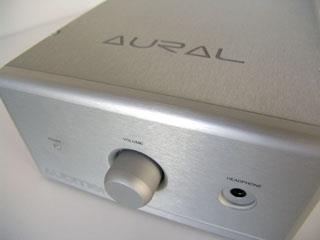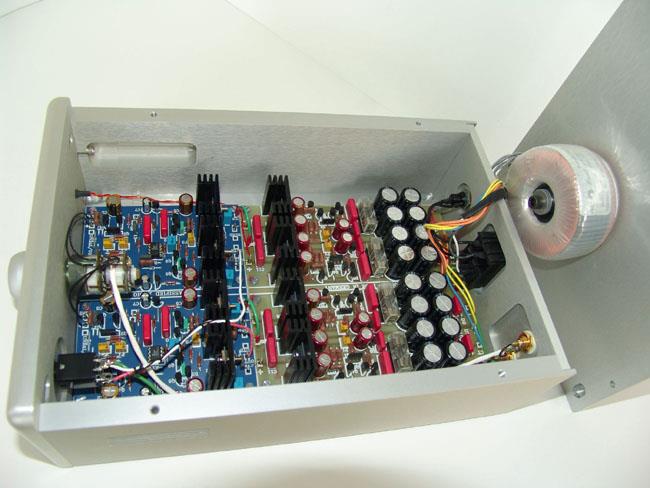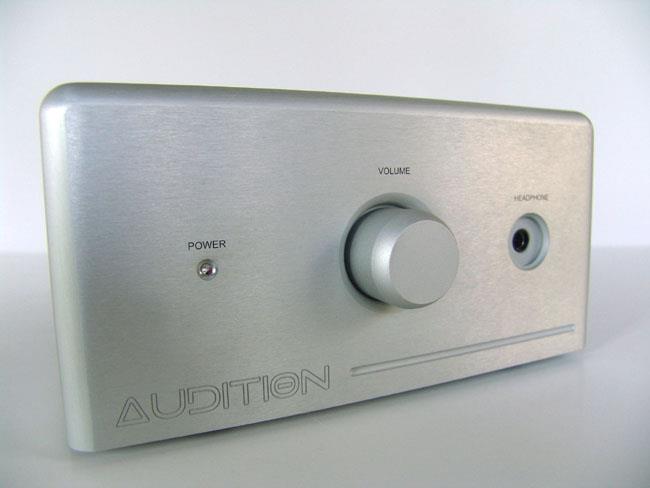|
|

|
|
Specifications
● Closed Loop Gain:
20 dB
●
Closed Loop Rise Time <0.2uS
●
Close Loop Output Impedance: <2 Ohms
●
Open Loop THD <0.05% Measured at
1 kHz/3 VRMS
●
Closed Loop Frequency Response 1 MHz
●
Compatible with Headphones from 32 to 600
Ohms
●
Power Consumption: 18 Watts
●
Dimensions: 4" H x 8" W x 12.75" D
● Weight: 17 Pounds
●
Warranty Parts and Labor: 3 Years
● MSRP:
$1995 USA Factory Direct, $2195
at Dealers
Aural Audio
www.auralaudio.com |
|
Introduction
When John Johnson asked me to review this solidly constructed headphone amp,
my ears perked up. Just a few months back, I had the opportunity to review
the Manley 300B preamplifier, one of whose main attractions is the
beautiful sound produced through its headphone output in part by its pair of 300B tubes. I was happy to
have the opportunity to audition a second high-end headphone amp, this time
a solid-state design, and to compare between the two.
The Manley experience required me to borrow Grado RS-1 and Sennheiser HD600
headphones. I greatly preferred the Grados, characterizing their sound as
“quite satisfying. Highs were alive and vibrant, bass well defined, with a
decent amount of air in between and around sounds.”
I also very much enjoyed the Manley, praising its “innately musical sound.”
I certainly preferred it to the Grado battery powered headphone amp that
came with the headphones, which
despite its quietness and extremely low noise floor delivered “some pretty
glass-shattering cymbals and a concomitant lack of air and grace.”
The Aural Audition headphone experience is a whole different ball game than
the Manley.
Technical
Aural Audition, manufactured by Classified Audio Video, Inc. of Jacksonville
Illinois, goes to great lengths in their user guide to extol their “high
performance reference amplifier. It not only has incredible power, but the
sound quality is unsurpassed and better than many so called high-end audio
headphone amplifiers, irrespective of price.” Their online flyer goes even
farther, stating that the Class A reference headphone amplifier “outperforms any and all headphone amplifiers on the market, irrespective of
price.”
High on the company's priority list is the use of 2% silver solder that offers low contact resistance. They exclusively rely on MOFSETs (Metal
Oxide Silicon Field Effect Transistors) in the output stage,
calling them superior to the standard bipolar devices found in other
headphone amps. They also claim that the Audition sounds more tube-like
than most solid-state amplifiers due to matched pairs of transistors and
other design techniques; they especially underscore its warmer, “more
musically appealing” sound.
The amp's separate and independent dedicated power supplies contain fast
recovery diodes, eight low ESR (Equivalent Series Resistance) filter
capacitors, and dual wide-band, low noise regulators using only FETs (JFETs
and MOFSETs) as active elements. The low-noise, high-current magnetically
shielded Toroid power transformer boasts dedicated windings for each
channel. Resistors are high quality Vishay-Dale and Caddocks. Other parts
include Nichicon Fine Gold Muse electrolytics and Mica or Polystyrene
compensation capacitors. A JFET input servo amp tracks output offset to less
than 1mV and operates below 1 Hz to be sonically inaudible. The chassis is
made from 1/2 inch anodized machined aluminum to improve grounding, thereby assuring a low noise floor. The output
jack is by Switchcraft, the stepped attenuator a DACT 10k CT-2. The designer
is Erno Borbely, formerly lead systems engineer for Hafler, Dynaco, and
Motorola Semiconductor.

The user manual doesn't bother to explain how to hook up and use the preamp
because it's such a simple device. The on-off switch is located in the rear.
When you plug the unit in and turn it on, a blue LED glows in front. There's
a single set of RCA inputs on the rear. The single output on the front
accommodates one set of headphones terminated with a standard 1/4" stereo phone plug.
Volume is controlled by the silent stepped attenuator centrally located on
the front of the amp. There are no visible numbers to help you remember
settings for individual recordings, so it's up to you to remember the number
of clicks from Ground Zero and run for cover if you click too high. Happily,
volume increments are pretty close, so a click or two above ideal listening
volume will not tend to harm your eardrums.

Set-Up
I isolated the amp from vibration using three Ganymede ball-bearing
suspension feet. Power and interconnects were courtesy of Nordost Valhalla.
All connections were first cleaned with 99% isopropyl alcohol and then
conditioned with Caig Pro Gold. Many manufacturers recommend this product
because of its superior conductivity. I also first ran the system
(including headphones) using the five-minute sweep on the Ayre break-in
disc.
My initial listening session took place within hours of connecting the unit.
I was less than overjoyed with what I heard. The sound was so dry that I
hoped for Aural Audition's sake that the headphone amp was not broken-in. I
thus ran the Ayre disc's break-in signal (a variation of white noise) for a
good 75 hours more before taking a second listen. Though there were major
improvements, reservations remained.
I then wrote company honcho Larry Black, who informed that my unit had only
about 40 hours of continuous play on it when it was shipped to John for
testing.
“Most of my customers say they hear a difference after the amp has 100 hours
on it,” replied Larry.
“One question that I always seem to get asked is about leaving the amplifier
on all the time. The output MOSFETs are biased at 70mA each. However with
the heatsinks used and convection cooling from the chassis, there is no
problem is leaving the amp on all the time. In fact, I prefer to listen that
way.”
I thus gave the unit benefit of the doubt, and made sure it had broken-in
for a good 125 hours before recording my opinions for this review. Why some
manufacturers do not take the time to break in units before sending them to
reviewers remains a mystery (and great source of frustration) to me. I know
that more and more manufacturers now perform at least minimal break-in
because they find it makes a significant difference in potential buyer
response.

Listening
Once well on its way to being completely broken-in, this headphone amp
shines. I preferred it best on simple fare. For example, Arianna Savall's
exquisite Bella Terra (Alia Vox) sounds gorgeous through the Aural Audition/Grado
combination. I get a sense of being right next to her harp, its
multi-layered simplicity plucking in my ears. The smile in Savall's
winning voice and her youthful sincerity are equally satisfying. I could
listen for hours to this disc through the Aural Audition and Grado
headphones.
One of the Aural Audition's key strengths lies in its ability to convey fine
detail without in any way sounding etched or unnatural. The unit brings me
right up to the microphone, leaving me feeling that whatever it picks up,
I hear. (This is not something I remember from my time with the Manley,
which replaced the microscope effect with winning warmth.) For a student of
music or a reviewer, this ability to convey the smallest details is a
definite asset. I'm not sure I was previously aware of certain minor clicks
of bows on music stands in the quieter passages of the Rachmaninoff, even
though I've listened to the recording more times than I wish to recall.
In the same vein, the voice of 88 year-old Graciela on Candido & Graciela's
fabulous Inolvidable (Chesky) sounds a bit more worn through the Aural
Audition than when heard through the Jadis Defy 7 and Talon Khorus X
speakers. It's not that my reference system smudges detail. But the sense of
bloom afforded by tubes and the forgiveness of the space between speaker
cones and ears certainly helps along an awesome voice that is nonetheless
well beyond the its first blush.
I certainly don't get the Aural Audition's sense of detail listening through
headphones connected to my aged Sony portable CD player. In fact, when I
plug the Grados into it, what I'm most aware of is the unit's ability to
smudge details to the nth degree. In terms of resolution, the Aural Audition
scores a solid 10.
Nor does the Aural Audition sound “solid-state” in the usual sense. It
absolutely has a midrange, capped by a vibrant if not overly glistening top
and a full if not exactly cavernous bottom. (It may in fact be more extended
at the extremes of the range than the Manley, which does tend to truncate at
both ends.) If the Aural Audition's midrange isn't particularly warm or fat,
if the images seem flatter and less full than they do through the Manley
300B, they are still satisfying. And there is nothing hard, strident, or
off-putting about the Aural Audition's highs.
Those who have read my Nordost Valhalla power cable review know how much I
enjoy the sense of boundless space, natural timbre, and clarity that these
cables bring out in equipment. Even with those cables powering both the
Aural Audition and transport, however, there is a definite sense of music
being compressed into a small space. The fabled “sound of the hall” is for
the most part absent. There is simply less air around individual instruments
and the presentation as a whole.
When it comes to large-scale music, for example Rachmaninoff's Symphonic
Dances (Reference Recordings), the lack of a large soundstage and of sound
bouncing off the walls of the hall is a definite disappointment. My memory
of how the Rachmaninoff sounded with the Manley 300B is foggy at best, so I
cannot truthfully say if the diminution I feel is more a product of the
headphone experience per se or of this piece of this headphone amp in
particular. But without the huge expanse and the all-important sense of air
around the orchestra, the experience falls somewhat flat. The same is true
for Terry Evans' Puttin' it Down (JVC XRCD), where the layout of and space
between instruments is captivatingly large.
There is also no getting around the fact that, as free of many of
solid-state's major faults as the Aural Audition may be, its sound lacks the
ultimate warmth, roundness, and bloom of a tube headphone amp such as the
Manley 300B (which in all fairness costs over $3000 more than the Aural
Audition). To these ears, the musicality of tubes wins out. But for others,
the extraordinary sense of up-close detail, extension at extremes, and more
reasonable price of the Aural Audition will more than compensate.
Conclusions
The Aural Audition offers a listening experience worthy of comparison to
other leading headphone amplifiers. If it does not exactly achieve its claim
to outperform each and every one under the sun on every level imaginable, it
nonetheless offers an enviable degree of clarity, detail, extension, and
sheer listenability. Definitely demanding of audition, with the caveat that
you must put your choice of break-in disc(s) on repeat and let 'er rip for a
minimum of five days before you can begin to appreciate what this unit can
deliver.
- Jason Victor Serinus -
Associated Equipment:
Digital Front End
Sony 707ES transport modified by Alexander Peychev of APL Hi-Fi
Theta Gen VIII DAC/Preamp
Amplification
Jadis Defy 7 Mk III or IV modified with a Siltech silver harness
Loudspeakers
Talon Khorus X speakers MK. II (with latest modifications and Bybee filters)
Cabling
Nordost Valhalla single-ended and balanced interconnects and balanced digital
interconnects
Nordost Valhalla bi-wired speaker cable
Acoustic Zen Silver Reference II balanced interconnects
Either Harmonic Tech Magic One, Nordost Silver Shadow, or Nirvana digital
interconnect for DVD-V
Power cables: Nordost Valhalla and Nordost Vishnu; Elrod EPS Signature 2 and 3
plus EPS 1, 2, and 3; WireWorld Silver Electra 5, PS Audio X-treme Statement,
Harmonic Tech, and AudioPrism SuperNatural S2.
Accessories
PS Audio P600 Power Plant power synthesizer with MultiWave II
PS Audio Ultimate Outlet; PS Audio Power Ports
Michael Green Deluxe Ultrarack, Basic Racks and room treatment
Ganymede supports in main digital chain and under speakers
Michael Green Audiopoints, and Black Diamond Racing Cones elsewhere
Shakti stones for Amp and Theta
Stillpoints ERS EMI/RFI sheets on some components
Bedini Dual Beam Ultraclarifier
Audioprism CD Stoplight
Marigo as yet unreleased Signature Mat for use atop CDs
Ayre demagnetising CD and the original Sheffield/XLO degmagnetising and break-in
CD.
Analog
Dual 1219
Sumiko Blue Point cartridge
Classe 6 phono preamp with optional umbilical cord
Interconnects: Tara Decade and Nirvana SL-1
Terms and Conditions of Use

|







